
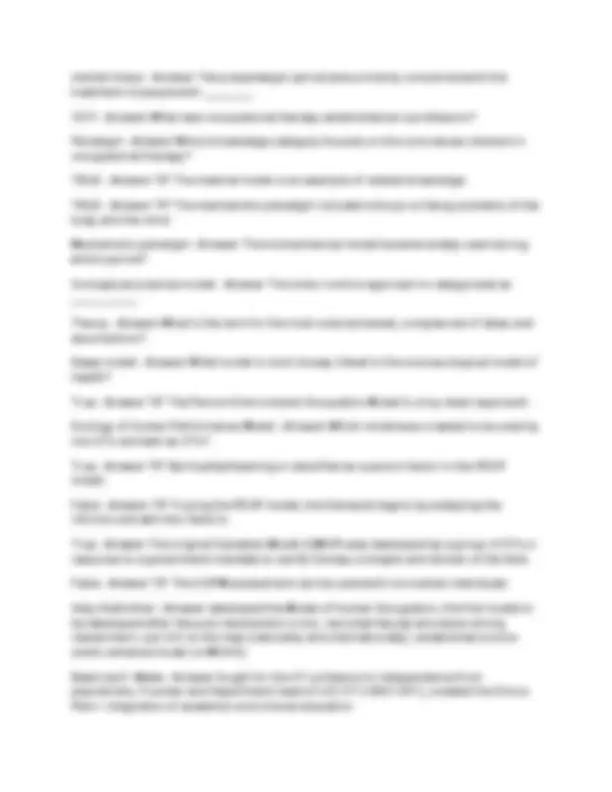
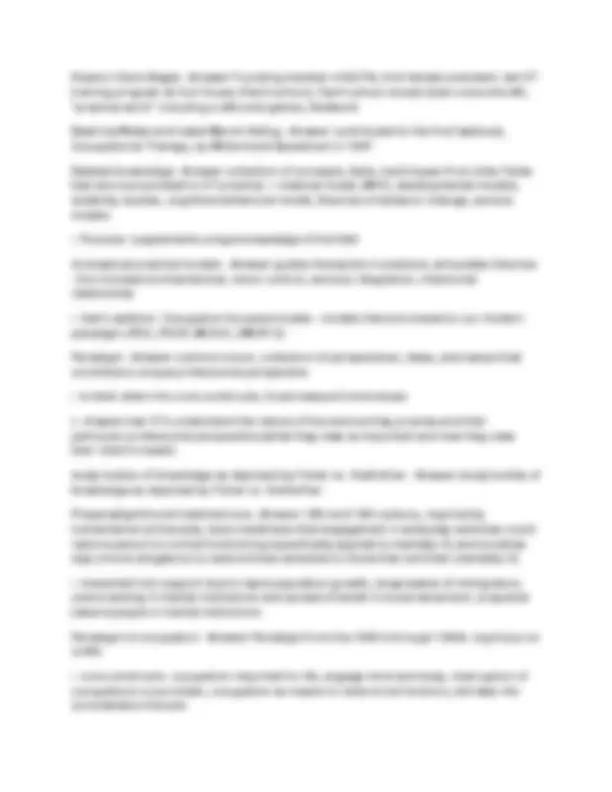
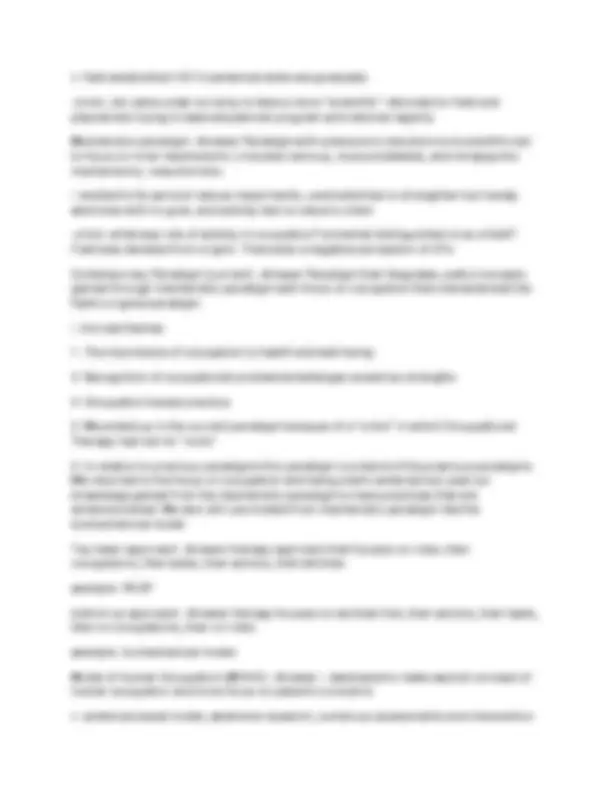
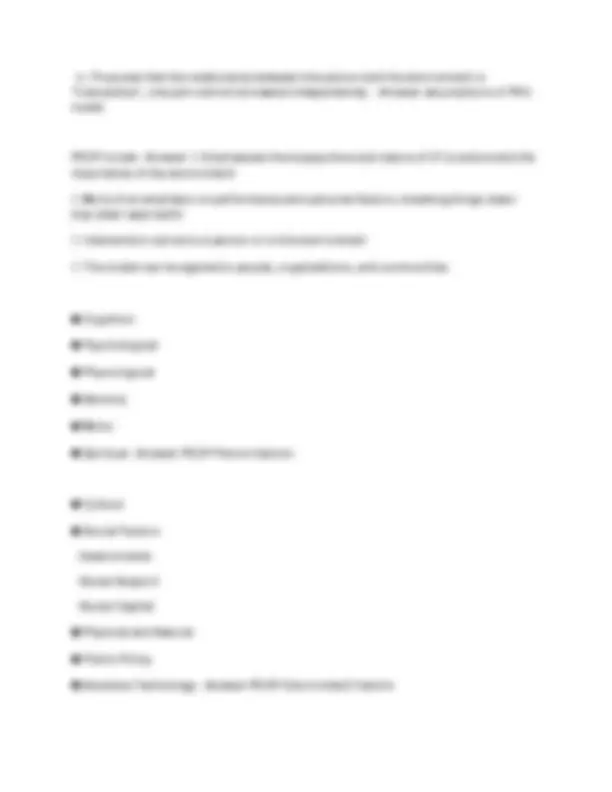
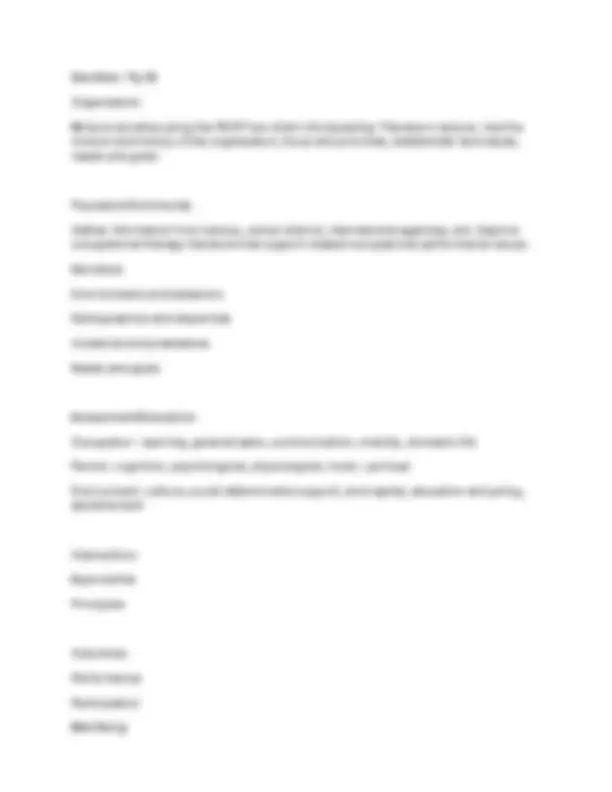
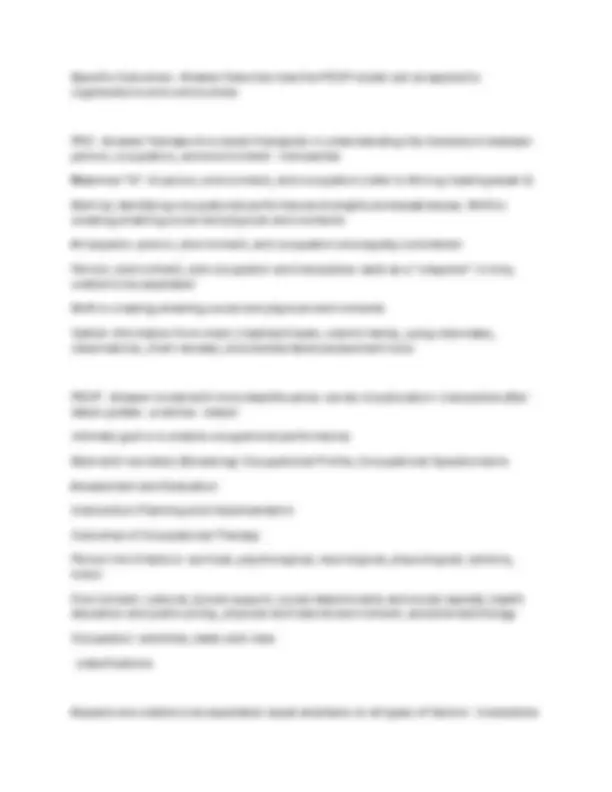


Study with the several resources on Docsity

Earn points by helping other students or get them with a premium plan


Prepare for your exams
Study with the several resources on Docsity

Earn points to download
Earn points by helping other students or get them with a premium plan
Community
Ask the community for help and clear up your study doubts
Discover the best universities in your country according to Docsity users
Free resources
Download our free guides on studying techniques, anxiety management strategies, and thesis advice from Docsity tutors
OT500 EXAM QUESTIONS AND VERIFIED ANSWERS
Typology: Exams
1 / 12

This page cannot be seen from the preview
Don't miss anything!







Theory - Answer the most complex and well developed entity when compared to other terms
- A set of interrelated ideas or concepts, assumptions, relationships and propositions that are used to understand, explain and predict phenomena or behavior - An image or explanation of why or how a phenomenon occurs, such as a change process, or how something works **- Provides tools that people use to guide their actions
Model)
- Occupation -focused models: Broad overarching models, such as MOHO, CMOP-E , PEO - Narrow theories or models - (or frames of reference) - refer to discrete performance areas, provide principles on what assessment to use, what intervention to present (e.g. biomechanical, motor control, sensory integration, cognitive models), often created by people outside the field but applied in occupational therapy with assessments and treatment practices that are created and described by occupational therapists. Kielhofner calls these conceptual practice models but frame of reference is a term that is used to describe a set of assumptions that guide one's behavior. Framework - Answer Descriptive tool that can be used to organize and define concepts, assists with thinking and can guide action, not as well developed as a model, does not have practice resources or research. used to organize & define concepts, assist with thinking & guide action, frameworks help to lead through a thought process example: OT practice framework MOHO Volition - Answer "motivation", personal causation (includes self-efficacy), values and interests MOHO Habituation - Answer habituation of "patterns", habits, roles, and routines "Ability to do" is influenced by objective components and subjective experience - Answer What is the MOHO Performance Capacity? MOHO Environment - Answer Spaces, objects, occupational tasks, and social groups, also culture and economic/political conditions MOHO Dimensions of Doing - Answer Occupational identity, occupational competence, and occupational adaptation PEOP model - Answer "a client-centered model organized to improve everyday performance of necessary and valued occupations of individuals, organizations, and populations and their meaningful participation in the world around them" (Baum & Christiansen, 2005). Person-Environment-Occupation-Performance Model - Answer PEOP Canadian Model of Occupational Performance and Engagement - Answer CMOP-E True - Answer T/F Eleanor Clarke Slagle was one of the first students to take a course in therapeutic occupations at the Hull House. False - physiatrists, not psychiatrists - Answer T/F One of Beatrice Wade's important contributions was to keep OT autonomous from psychiatrists.
Eleanor Clark Slagle - Answer Founding member of AOTA, first female president; led OT training program at Hull House (Favill school), Favill school closed down once she left, "practice work" including crafts and games, fieldwork Beatrice Wade and Isabel March Kellog - Answer contributed to the first textbook, Occupational Therapy, by Willard and Spackman in 1947. Related knowledge - Answer collection of concepts, facts, techniques from other fields that are incorporated to OT practice → medical model, WHO, developmental models, disability studies, cognitive-behavioral model, theories of behavior change, service models i. Purpose: supplements unique knowledge of the field Conceptual practice models - Answer guides therapists in practice, articulates theories
ii. field established 1917 (centennial when we graduate) -crisis: ots came under scrutiny to have a more "scientific" rationale for field and physiatrists trying to take educational program and national registry Mechanistic paradigm - Answer Paradigm with pressure to become more scientific led to focus on inner mechanisms ( includes nervous, musculoskeletal, and intrapsychic mechanisms); reductionistic i. wanted to fix person/ reduce impairments, used activities to strengthen but merely exercises with no goal, and activity had no value to client -crisis: what was role of activity in occupation? and what distinguished ot as a field? Field was derailed from origins. There was a negative perception of OTs. Contemporary Paradigm (current) - Answer Paradigm that integrates useful concepts gained through mechanistic paradigm with focus on occupation that characterized the field's original paradigm. i. 3 broad themes:
iv. core concepts: enablement ("model of helping that promotes empowerment"), social justice, env. v. not just performance in occupation but participation vi. also spirituality at the center of person which is unique to the model Occupation Adaption (OA) - Answer i. developed by texas women's university as a framework for doctoral program ii. focus on adaptation process, which occurs as a result of inherent desire for mastery and emerges from interaction between person and environment. iii. focus on enhancement of processes not skills Ecology of Human Performance (EHP) - Answer model that i. has very much focus on environment (primary context performance to be understood) ii. developed to be used as interdisciplinary model iii. human performance is result of interaction between person, context, and task iv. 5 categories of interventions: establish/restore, alter, adapt, prevent, create (now part of OT practice framework).
Kawa Model - Answer Model that means river in Japanese. ii. developed to address perceived need to non-western model iii. more of collective model-eastern focus (non-western) iv. used with clients and families as a way to see life in different context (only model for clients to use)
a transactive model, there is no hierarchy with person/environment/occupation factors, all are equally important, top down approach with helping the client accomplish what they want in their environment (as opposed to fixing the person) - Answer essential elements of the PEO model
Occupational performance is the result of interconnectedness and fit between the person, environment, and occupation. ii. Person, environment, and occupation are not examined separately, rather they are analyzed as a snapshot, an event in time.
iii. Proposes that the relationship between the person and the environment is "transactive", one part cannot be viewed independently. - Answer assumptions of PEO model
PEOP model - Answer ○ Emphasizes the biopsychosocial nature of OT practice and the importance of the environment ○ More of an emphasis on performance and personal factors, breaking things down (top-down approach) ○ Intervention can be to a person or to the environment
○ The model can be applied to people, organizations, and communities
● Cognition ● Psychological
● Physiological
● Sensory
● Motor
● Spiritual - Answer PEOP Person factors
● Culture
● Social Factors -Determinants -Social Support -Social Capital ● Physical and Natural
● Public Policy ● Assistive Technology - Answer PEOP Environment Factors
Specific Outcomes - Answer Describe how the PEOP model can be applied to organizations and communities
PEO - Answer framework to assist therapists in understanding the interaction between person, occupation, and environment - transactive Maximize "fit" of person, environment, and occupation (refer to Strong reading week 3) Start by identifying occupational performance strengths and weaknesses- Shift to creating enabling social and physical environments All aspects- person, environment, and occupation are equally considered Person, environment, and occupation are transactive- exist as a "snapshot" in time, unable to be separated Shift to creating enabling social and physical environments Gather information from client, treatment team, client's family, using interviews, observations, chart reviews, and standardized assessment tools
PEOP - Answer model with more depth/nuance- series of publication- transactive after latest update - practice - based Ultimate goal is to enable occupational performance Start with narrative (Screening) Occupational Profile, Occupational Questionnaire Assessment and Evaluation Intervention Planning and Implementation Outcomes of Occupational Therapy Person into 6 factors- spiritual, psychological, neurological, physiological, sensory, motor Environment- cultural, [social support, social determinants and social capital], health education and public policy, physical and natural environment, assistive technology Occupation- activities, tasks and roles classifications
Aspects are unable to be separated- equal emphasis on all types of factors - transactive
The performance of occupation (doing) Enables participation (engagement) In everyday life that contributes to a sense of well-being (health satisfaction and quality of life) Emphasis on inclusion of client in decision making/ treatment planning
CMOP-E - Answer aims to make explicit the relationship between person, environment, and occupation. This model believes that occupation is "the bridge that connects person and environment" · Key concepts: Enablement, social justice, and environment · Emphasis on spirituality at the core of the person (Physical- the doing, cognitive-the thinking, affective- the feeling) · Environment broken down into physical (built world and natural world), social (micro- personal, meso- interactions within family and social group, and macro- social structures, policies, regulations, and expectations), cultural, and institutional · Occupation broken down into productivity, self-care, and leisure (COPM) · Delineates the areas that are outside of the domain of OT How to apply: base intervention on client goals, considering his/her own personal motivation, providing "just right" challenge, and advocating for social justice needs "Humans are occupational beings" "Occupation has therapeutic potential" "Occupation affects health and well-being" "Occupation organized time and brings structure to living" "Occupation brings meaning to life through the combination of cultural and individual influences on the creation of meaning"
How to apply: base intervention on client goals, considering his/her own personal motivation, providing "just right" challenge, and advocating for social justice needs
Canadian Occupational Performance Measure (COPM) - Answer Measure that involves: